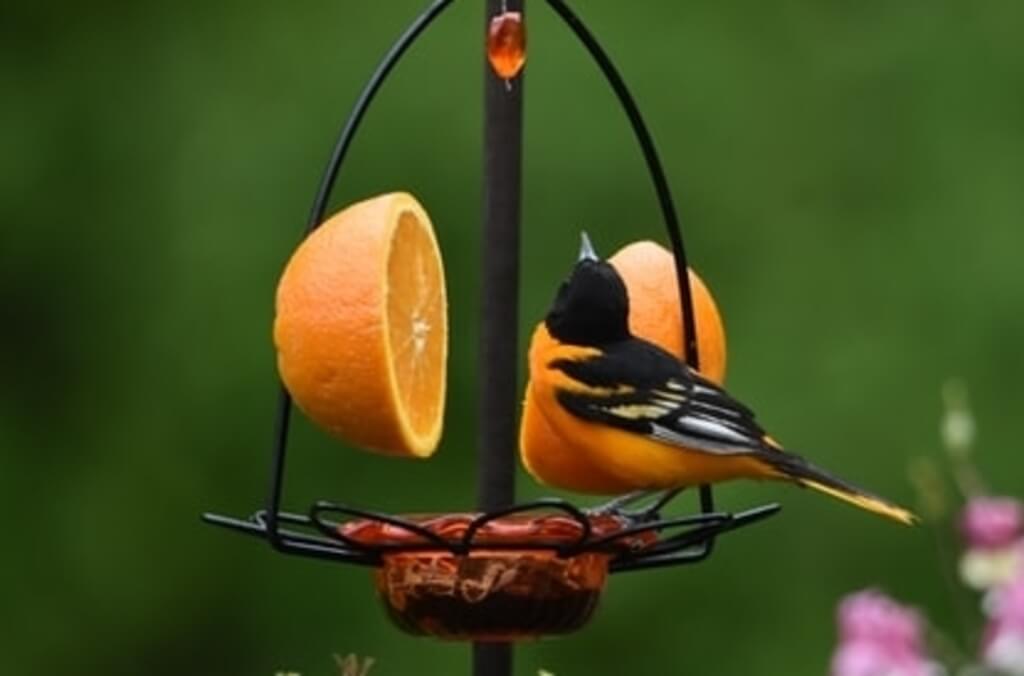Spotting a Baltimore Oriole can be a breathtaking experience, whether you’re an avid birdwatcher or just happen to glance out your window. With its vibrant orange and black plumage, this striking bird is not only a visual delight but also rich in symbolism and meaning.
In various cultures and beliefs, the presence of a Baltimore Oriole can signify different things, from messages of joy and positivity to deeper spiritual insights. Join us as we explore the fascinating symbolism behind encountering a Baltimore Oriole and what it might mean for you.
Table of Contents
- 1 What It Means If You See A Baltimore Oriole?
- 2 Introduction to Baltimore Orioles
- 3 Symbolic Meanings of Baltimore Orioles
- 4 Interesting Facts About Baltimore Orioles
- 5 Attracting Baltimore Orioles to Your Yard
- 6 Observing Baltimore Orioles in the Wild
- 7 Conservation Efforts for Baltimore Orioles
- 8 Similar Birds to Baltimore Orioles
- 9 Conclusion: Appreciating the Beauty of Baltimore Orioles
- 10 Frequently Asked Questions
- 11 Overall Conclusion
- 12 Author
What It Means If You See A Baltimore Oriole?
Seeing a Baltimore Oriole can hold symbolic meaning. It often represents joy, creativity, and a connection with nature.
Its vibrant colors and beautiful song symbolize happiness, inspiration, and the arrival of positive energies. Spotting a Baltimore Oriole can be a sign to embrace and celebrate these aspects in life.
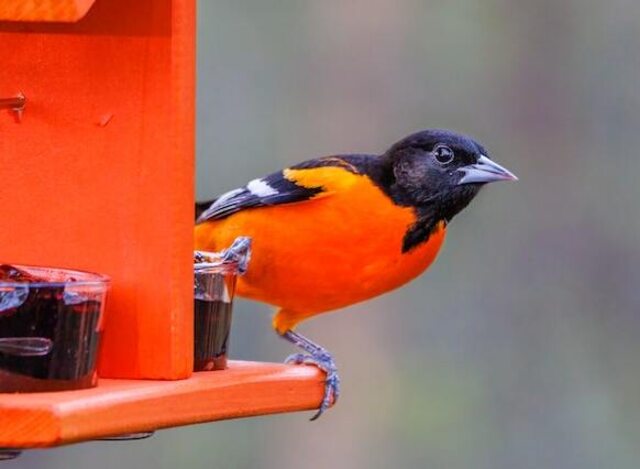
Introduction to Baltimore Orioles
The following section provides an introduction to a well-known bird species commonly found in parts of North America with distinctive black and orange plumage.
Baltimore Orioles are known for their vibrant colors and are a common sight in the eastern United States during the summer months.
They are migratory birds and spend their winters in Central and South America.
Baltimore Orioles prefer to nest in deciduous trees and are often found in woodlands, suburban areas, and parks.
They are medium-sized birds with a wingspan of approximately 8–10 inches and a weight of 1–2 ounces.
Males have a bright orange breast and black wings and tail, while females have a duller orange breast and grayish-brown wings and tail.
Orioles have a unique bill shape that is adapted for feeding on fruit, nectar, and insects.
With this information about their habitat and physical characteristics, we can now explore the symbolic meanings of Baltimore Orioles.
Symbolic Meanings of Baltimore Orioles
Baltimore Orioles have been associated with various symbolic meanings and cultural significance, which have been explored by researchers to uncover the depth of their symbolic value.
In Native American cultures, the oriole is often depicted as a messenger of good news, bringing messages of hope and positivity.
In Chinese culture, the oriole is a symbol of good fortune, representing prosperity and happiness.
In European medieval art, the oriole was a symbol of the resurrection, representing the triumph of life over death.
The oriole’s bright orange plumage has also been associated with the sun, and its sweet song has been likened to music from heaven.
Overall, the Baltimore oriole holds significant symbolic value across cultures and time periods.
In the subsequent section, we will explore some interesting facts about Baltimore Orioles.

Interesting Facts About Baltimore Orioles
The Baltimore Oriole is a fascinating bird species with intriguing characteristics. Its migration patterns are remarkable, as it travels long distances between its breeding and wintering grounds.
The bird’s diet and feeding habits are also intriguing, as it primarily feeds on insects and nectar.
Additionally, the Baltimore Oriole’s reproduction and nesting behaviors are interesting, as they build intricate and pendulous nests.
Migration Patterns
Understanding the migration patterns of the Baltimore oriole can provide valuable insights into their ecological needs and conservation efforts.
These birds are neotropical migrants, meaning they spend the winter in Central and South America and return to North America during the breeding season.
Their migration is a remarkable feat, as they fly thousands of miles across multiple countries to reach their destination.
Bird behavior and environmental impact play a significant role in their migration, as they need specific habitats to feed and rest during their journey.
Conservation efforts must focus on protecting these habitats to ensure the orioles have the resources they need to complete their journey successfully.
Additionally, studying the migration patterns of these birds can help scientists understand the larger ecological system and the impact of climate change on migratory birds.
Understanding the migration patterns of these birds is crucial for their conservation and the preservation of the natural environment.
This understanding can also inform future research on the diet and feeding habits of these birds, which we will delve into in the subsequent section.
Diet and Feeding Habits
Studying the feeding behavior and nutritional requirements of neotropical migrant birds, like the Baltimore oriole, can provide valuable insights into their ecological niche and the larger impact of climate change on migratory species.
Orioles are primarily insectivorous, feeding on a variety of insects such as caterpillars, beetles, and spiders. They also consume nectar and fruit, making them important pollinators and seed dispersers.
To meet their nutritional needs, orioles have developed unique feeding behaviors such as gleaning, where they pluck insects from leaves, and hovering, where they feed on nectar from flowers.
Understanding the dietary preferences and behaviors of Baltimore orioles is essential for their conservation, as changes in their food sources due to climate change can have significant impacts on their survival and reproductive success.
Moving forward, it is important to continue researching these birds’ feeding habits to better understand their ecological niche and how we can support their populations.
In the subsequent section about reproduction and nesting, we will explore how these feeding habits impact the orioles’ breeding success.
Reproduction and Nesting
This section delves into the reproductive and nesting behaviors of neotropical migrant birds, providing insights into the ecological niche of Baltimore orioles and the potential impact of climate change on these migratory species.
Baltimore Orioles are monogamous and breed once a year, typically arriving in their breeding grounds in May.
The male will court the female through song and dance, and both partners will work together to build a pendulous nest made of plant fibers, grasses, and hair.
The female will lay 3–7 eggs that will incubate for approximately 12–14 days. The chicks will fledge after 12–14 days, and both parents will continue to feed them for up to 3 weeks post-fledging.
Baltimore orioles require specific nesting materials and habitat to successfully breed, and climate change may impact their breeding success by altering the timing of migration and availability of nesting materials.
Attracting Baltimore orioles to your yard can be achieved by providing a suitable habitat with water, food, and nesting materials.
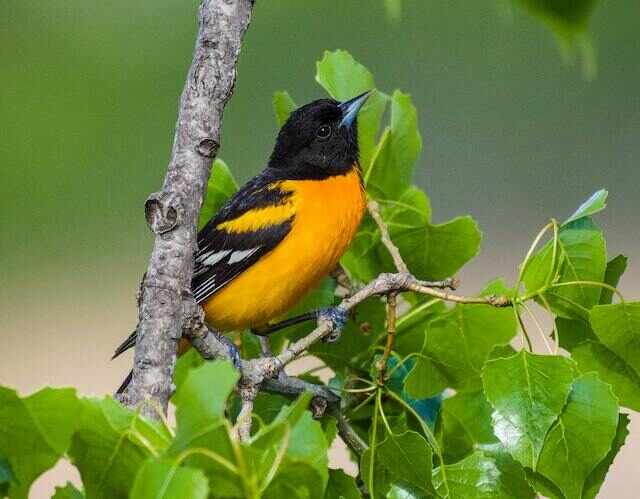
Attracting Baltimore Orioles to Your Yard
Attracting Baltimore Orioles to your yard can be achieved by providing food and water, as well as creating suitable nesting sites.
Orioles are attracted to nectar-producing flowers such as trumpet vine, bee balm, and jewelweed. Providing oranges, grape jelly, and mealworms can also entice them to visit your yard.
To create nesting sites, consider planting trees such as dogwood, red maple, and American elm, and providing nesting materials such as string, yarn, and hair.
Providing Food and Water
While it may seem counterintuitive to some, withholding food and water from the environment can actually be an effective way to attract Baltimore orioles to a particular area.
These birds are attracted to natural food sources like fruit, nectar, and insects. Providing them with these types of food, especially those that are native to the area, can help to draw them in.
Additionally, Baltimore Orioles are known to be attracted to water sources, so providing a clean and reliable water source can also be helpful.
Consider adding a bird bath or small pond to your yard to attract them.
Once you have successfully attracted Baltimore orioles to your yard, the next step is to create nesting sites.
Creating Nesting Sites
Providing food and water is essential for attracting Baltimore Orioles to your backyard, but creating nesting sites is equally important. Baltimore Orioles are cavity nesters and prefer to build their nests in the branches of tall trees.
You can create nesting sites for Baltimore Orioles by installing DIY projects such as nesting boxes or gourds. These structures mimic the natural cavities that the birds seek out.
Not only will creating nesting sites attract Baltimore Orioles to your yard, but it can also benefit other bird species that use the nesting boxes or gourds.
By providing nesting sites, you can contribute to the conservation of bird populations.
As you continue to observe these beautiful birds in your backyard, it is important to be aware of their behaviors and habits in the wild.
Observing Baltimore Orioles in the Wild
Observing Baltimore Orioles in the wild can be a thrilling experience for bird watchers. To spot them, it is best to know their preferred habitats such as open woodlands, orchards, and gardens.
For successful bird watching, one should be patient, quiet, and have a good pair of binoculars to get a closer look at their distinct orange plumage.
Best Places to Spot Them
This section highlights the optimal locations for viewing the vibrant and strikingly patterned Baltimore Oriole in its natural habitat.
If you want to catch a glimpse of these beautiful birds, it’s important to know the best times and ideal habitats for spotting them. Here are three of the top places to see Baltimore Orioles in the wild:
- Forested areas: Baltimore Orioles tend to prefer deciduous forests with a mix of large trees and smaller understory plants. Look for them in wooded areas with open spaces and plenty of sunlight.
- Gardens and orchards: Baltimore Orioles are attracted to fruit trees, especially those that produce sweet, juicy fruits like cherries, grapes, and oranges. They also enjoy nectar-rich flowers like trumpet vines, bee balm, and milkweed.
- Wetlands and marshes: Baltimore Orioles are known to frequent wetlands and marshes during their migration, so these areas can be great places to spot them. Look for them near water sources, such as streams, ponds, and rivers.
By knowing where to look, you can increase your chances of spotting a Baltimore Oriole in its natural habitat. Once you’ve found a good spot, it’s important to be patient and quiet, as these birds can be skittish.
In the next section, we’ll provide some tips for successful bird watching.
Tips for Bird Watching
Enhancing one’s bird watching experience involves adhering to a set of guidelines that necessitate patience, silence, and astute observation skills.
Bird identification is a crucial aspect, and it is imperative to have a good pair of binoculars, a field guide, and a notepad to record observations.
One must wear earth-toned clothes that blend with the surroundings and avoid wearing perfumes or scents that may disturb the birds.
To avoid disturbing the birds, it is essential to maintain a safe distance, not to make sudden movements, and refrain from feeding them.
It is crucial to respect the birds’ habitats, and one should avoid disrupting their nests or disturbing them during the breeding season.
One must also be aware of the weather conditions and time of day, as some birds prefer to come out during specific times.
Equipment needed for bird watching may vary depending on the type of bird and the location.
Following these guidelines will not only enhance the bird watching experience but also contribute to conservation efforts for baltimore orioles, the next section.
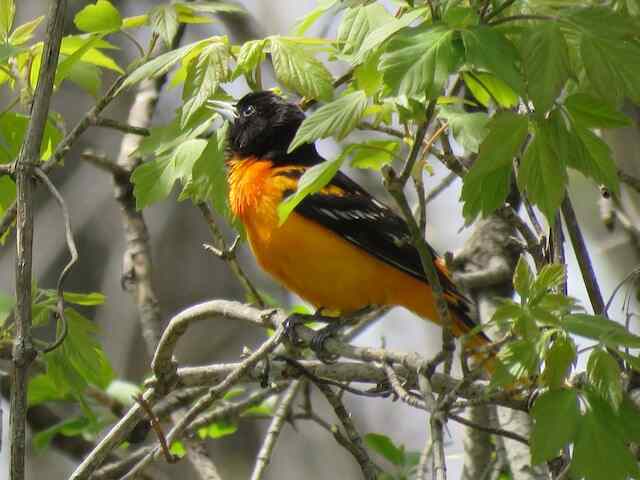
Conservation Efforts for Baltimore Orioles
The preservation of Baltimore Orioles involves implementing effective conservation measures to safeguard their habitats and nesting sites, which are crucial for their survival.
The Baltimore oriole population has been declining due to habitat loss caused by human impact such as deforestation and urbanization.
To prevent further loss, conservation efforts are put in place to protect their habitats and promote the planting of native trees that provide the essential food and nesting requirements for these birds.
Additionally, bird-friendly measures such as reducing the use of pesticides and keeping cats indoors can help to increase their survival rates.
It is important to recognize the value of Baltimore Orioles in maintaining a healthy ecosystem and to take action to conserve them.
As we move forward, it is essential to consider similar birds to Baltimore orioles and their conservation status to ensure the protection of all avian species.
Similar Birds to Baltimore Orioles
Conservation efforts for Baltimore Orioles are crucial to their survival, and it’s important to recognize other birds that may share similar characteristics.
Bird identification and bird watching techniques can aid in distinguishing between the Baltimore Oriole and other birds.
Some birds with similar features include the Orchard Oriole, Bullock’s Oriole, and the Black-headed Grosbeak.
By observing the differences in their plumage, size, and behavior, bird enthusiasts can accurately identify these species.
Additionally, bird watching can be an enjoyable and educational activity for all ages.
With the proper knowledge and techniques, individuals can appreciate the beauty and diversity of these amazing creatures.
Conclusion: Appreciating the Beauty of Baltimore Orioles
Appreciating the unique beauty and diverse characteristics of various bird species, including the Baltimore Oriole, can promote a greater understanding and connection to the natural world.
The Baltimore Oriole’s vibrant orange plumage and melodic songs make it a popular subject of bird photography and a beloved symbol of springtime.
Observing and appreciating the Baltimore Oriole’s behavior and habitat can provide insight into the interconnectedness of the natural world and the importance of preserving biodiversity.
By taking the time to appreciate the beauty of birds like the Baltimore Oriole, we can develop a deeper appreciation for the intricacies of the natural world and the importance of protecting and preserving it for future generations.
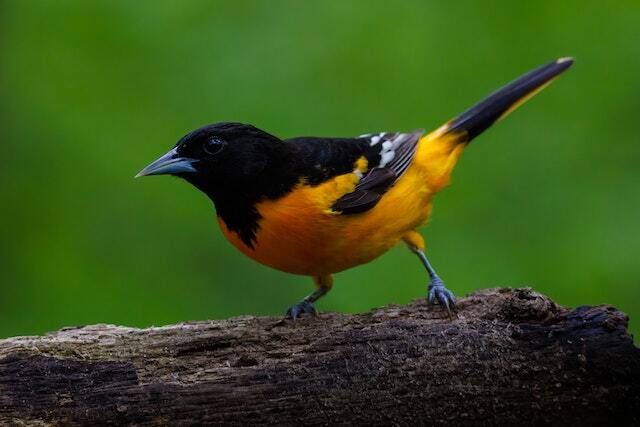
Frequently Asked Questions
What is the habitat range of Baltimore Orioles?
As one of the most vibrant and striking birds in the American landscape, the Baltimore Oriole has captured the imagination of bird watchers and nature enthusiasts alike.
Found throughout the eastern half of North America, from the Gulf Coast to Canada, this species of bird is known for its distinctive orange and black plumage.
However, beyond its visual appeal, the Baltimore Oriole is also notable for its habitat range and characteristics, as well as its nesting habits and survival strategies.
This bird typically dwells in deciduous forests, woodlands, and suburban areas, with a preference for open areas with mature trees.
Conservation efforts are underway to address the issues surrounding habitat destruction, as urbanization and deforestation continue to threaten the survival of this species.
Overall, the Baltimore Oriole represents a unique and important part of the natural world, and its continued existence depends on our collective efforts to preserve its habitat and ensure its survival.
How long do Baltimore Orioles typically live?
Baltimore Oriole Lifespan: How Long Do They Live?
The Baltimore Oriole is a small, migratory bird that is known for its striking orange and black plumage. These birds are found throughout much of North America and are a common sight in many gardens and parks.
The average lifespan of a Baltimore Oriole is around 6–8 years, although some individuals can live for up to 10 years in the wild.
Factors that can affect the lifespan of Baltimore Orioles include habitat quality, predation, disease, and climate change.
Despite these challenges, Baltimore Orioles have adapted well to human-dominated landscapes and are a welcome sight for birdwatchers and nature enthusiasts alike.
Understanding the lifespan and other aspects of the biology of these birds can help us better appreciate their value to our natural world and work to protect them for future generations.
What is the mating behavior of Baltimore Orioles?
As much as we’d like to imagine that Baltimore orioles have a passionate and romantic mating ritual, the reality is a bit more… underwhelming.
In fact, the Baltimore oriole mating ritual is pretty straightforward. The male will begin by singing to attract a female, and then he’ll perform a series of aerial displays to show off his agility and strength.
If the female is impressed, she’ll allow him to mate with her.
Breeding habits are similarly unremarkable, with the female building a nest and laying eggs while the male occasionally brings her food.
But despite the lack of fireworks, Baltimore orioles are fascinating creatures, and their mating rituals and breeding habits provide valuable insight into their lives and behavior.
What is the diet of Baltimore Orioles?
Baltimore Oriole Diet: What Do They Eat and Why? Exploring Baltimore Oriole Feeding Habits and Preferences.
Orioles are known for their preference for sugary nectar and fruits. They have a unique adaptation in their beaks that allows them to easily extract nectar from flowers.
However, their diet is not limited to just sweet substances. They also consume insects and spiders, which provide them with the necessary protein and essential amino acids.
Orioles have been observed to feed on caterpillars, beetles, grasshoppers, and other arthropods.
Interestingly, their feeding habits change throughout the year, with a preference for insects during breeding season and fruits during migration and winter.
This flexibility in their diet allows Orioles to adapt to different environments and ensure their survival.
Understanding these feeding habits and preferences can help us better conserve and protect these beautiful birds for future generations.
How do Baltimore Orioles migrate and where do they go?
Baltimore orioles are migratory birds that breed in North America and migrate to Central America and northern South America during the winter months.
Their migration patterns are influenced by a variety of environmental factors, including the availability of food, water, and suitable nesting sites.
During migration, these birds travel at night and use a combination of celestial cues and Earth’s magnetic field to navigate.
They also rely on stopover sites along their migration route to rest and refuel.
Understanding the migration patterns of Baltimore orioles is crucial for conservation efforts, as it helps researchers identify critical habitats and potential threats to their survival.
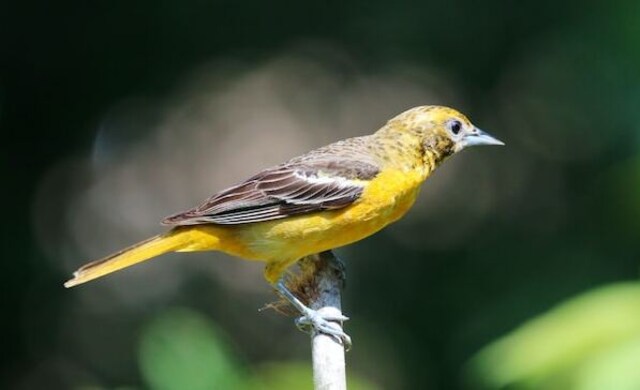
Overall Conclusion
Baltimore Orioles are stunning birds that can captivate anyone with their bright orange plumage and sweet songs. These birds have long been associated with symbolic meanings, representing a variety of concepts such as joy, creativity, and balance.
In addition, Baltimore Orioles are fascinating creatures with unique behaviors and interesting habits that make them a delight to observe.
To attract these beautiful birds to your yard, you can provide them with food, water, and shelter.
Observing Baltimore Orioles in the wild can be a rewarding experience, but it is important to do so responsibly, respecting their natural habitats and behaviors.
Additionally, conservation efforts are crucial for the survival of these birds, as they face threats from habitat loss and climate change.
In conclusion, Baltimore Orioles are not just any ordinary birds, but rather a symbol of beauty, creativity, and balance.
Their unique characteristics and stunning appearance make them a joy to observe and appreciate.
By taking steps to attract them to our yards and supporting conservation efforts, we can ensure that these magnificent birds continue to thrive and inspire us with their beauty for generations to come.

